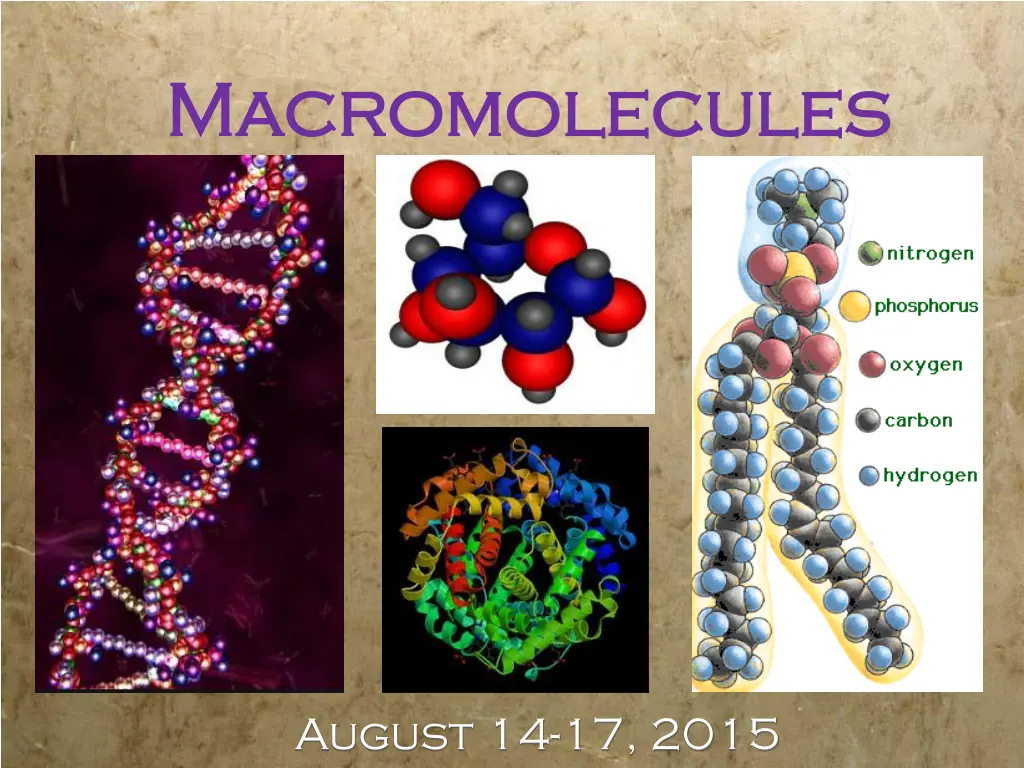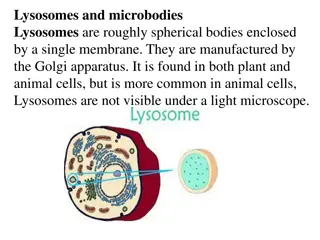
Understanding Macromolecules and their Functions
Explore the world of macromolecules, including carbohydrates, lipids, proteins, and nucleic acids. Learn about their structures, functions, and importance in biological systems. Dive into the details of monomers, such as monosaccharides, fatty acids, amino acids, and nucleotides, that form these essential molecules. Discover the diverse roles of macromolecules in storing energy, providing structural support, and carrying out vital biological processes.
Download Presentation

Please find below an Image/Link to download the presentation.
The content on the website is provided AS IS for your information and personal use only. It may not be sold, licensed, or shared on other websites without obtaining consent from the author. If you encounter any issues during the download, it is possible that the publisher has removed the file from their server.
You are allowed to download the files provided on this website for personal or commercial use, subject to the condition that they are used lawfully. All files are the property of their respective owners.
The content on the website is provided AS IS for your information and personal use only. It may not be sold, licensed, or shared on other websites without obtaining consent from the author.
E N D
Presentation Transcript
Macromolecules Macromolecules http://scienceforkids.kidipede.com/chemistry/organic/pictures/protein.jpg August 14-17, 2015
Objective Identify macromolecules and describe their Identify macromolecules and describe their functions functions
Macromolecules Macromolecules are large organic molecules that consist of chains of repeating subunits called monomers. Macromolecule Monomer Monosaccharides Fatty acids Amino acids Nucleotides
Macromolecules Macromolecules are large organic molecules that consist of chains of repeating subunits called monomers. Macromolecule Monomer Carbohydrates Lipids Proteins Nucleic Acids Monosaccharides Fatty acids Amino acids Nucleotides
Carbohydrates All have formula: CnH2nOn Classified as Monosaccharides (one) Disaccharides (two) Polysaccharids (many) Function in humans: Energy storage Glucose (monosaccharide)
Monosaccharides Glucose used to transport energy through the blood to all cells in the body Ribose found in nucleic acids
Monosaccharides Glucose used to transport energy through the blood to all cells in the body Ribose found in nucleic acids glucose ribose
Disaccharides Lactose Found in milk
Polysaccharides Glycogen Used for energy storage in liver & muscles Made of glucose molecules
Carbohydrate Quick Review 1) What are the 3 types of carbohydrates? 2) What is the main function of carbohydrates in humans? 3) How will you recognize a carbohydrate?
Lipids Diverse, but all are non-polar (thus hydrophobic) Type Triglycerides (fats & Oils) Type Function Function Energy storage, insulation Steroids (including cholesterol) Phospholipids Hormones, part of cell membrane Chief component of cell Membrane; Covers Nerves Vitamins (A, E, K) Vital for many functions
Triglycerides Fun Facts What s the difference between Oils vs. Fats?
Triglycerides Fun Facts What s the difference between Oils vs. Fats? Oils are liquid at room temperature, while fats are solid.
Triglycerides Fun Facts What s the difference between Saturated and Unsaturated Fats?
Triglycerides Fun Facts What s the difference between Saturated and Unsaturated Fats? Saturated fats are saturated with hydrogens and thus form a straight chain. Unsaturated fats have some double bonds, and thus are bent.
Energy Storage: Lipids Vs. Carbs LIPIDS Usually long-term More energy dense Cannot be easily transported Doesn t impact osmotic balance Less easily digested Carbs Usually short-term Less energy dense Can be transported Impacts osmotic balance More easily digested
Lipid Quick Review 1. What property do all Lipids share? 2. Name 3 examples of lipids in the body. 3. Why would we store excess energy as Fat, rather than carbohydrates?
Amino Acids Proteins are folded Proteins are folded--up chains of amino acids. up chains of amino acids. There are 20 There are 20 commonly commonly occurring occurring amino acids amino acids.
Protein structure http://www.rci.rutgers.edu/~uzwiak/AnatPhys/APFallLect2_files/image018.jpg
Functions of Proteins Function Example Details Shape Enzymes lactase Breaks down lactose globular Movement Slide past each other to cause muscle contraction myosin & actin Fibrous Transport hemoglobin Carries oxygen in blood globular Structural Tough fiber that provides strength collagen Fibrous Hormones insulin Regulates blood sugar globular Defense immunoglobins Antibodies globular Partial list only!
Nucleic Acids DNA: Genetic Information RNA: Transcribes and translates DNA to make proteins
Nucleotide structure Each nucleotide has three parts: A phosphate group A sugar A nitrogenous base (A, C, T, or G)
ATP The energy Currency of the Cell
Stop & Jot, then Share 1. Which macromolecule has the most complex structure? Why do you say that? 2. Which macromolecule has the most diversity of functions?
Quick Review Identify the macromolecule and Function RNA Phospholipid Glycogen Collagen Lactose Insulin






















